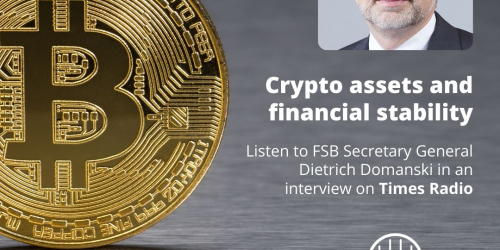This report examines developments and associated vulnerabilities relating to three segments of the crypto-asset markets: unbacked crypto-assets (such as Bitcoin); stablecoins; and decentralised finance (DeFi) and other platforms on which crypto-assets trade. These three segments are closely interrelated in a complex and constantly evolving ecosystem and need to be considered holistically when assessing related financial stability risks. The report notes that although the extent and nature of use of crypto-assets varies somewhat across jurisdictions, financial stability risks could rapidly escalate, underscoring the need for timely and pre-emptive evaluation of possible policy responses.
Crypto-asset market capitalisation grew by 3.5 times in 2021 to $2.6 trillion, yet crypto-assets remain a small portion of overall global financial system assets. Direct connections between crypto-assets and systemically important financial institutions and core financial markets, while growing rapidly, are limited at the present time. Nevertheless, institutional involvement in crypto-asset markets, both as investors and service providers, has grown over the last year, albeit from a low base. If the current trajectory of growth in scale and interconnectedness of crypto-assets to these institutions were to continue, this could have implications for global financial stability.
DeFi has recently become a fast-emerging sector, providing financial services using both unbacked crypto-assets and stablecoins. Moreover, a relatively small number of crypto-asset trading platforms aggregate multiple types of services and activities, including lending and custody. Some of these platforms operate outside of a jurisdiction’s regulatory perimeter or are not in compliance with applicable laws and regulations. This presents the potential for concentration of risks, and underscores the lack of transparency on their activities.
Charts are hoverable and filterable
Partly due to the emergence of DeFi, stablecoin growth has continued, despite concerns about regulatory compliance, quality and sufficiency of reserve assets, and standards of risk management and governance. At present, stablecoins are used mainly as a bridge between traditional fiat currencies and crypto-assets, which has implications for the stability and functioning of crypto-asset markets. Were a major stablecoin to fail, it is possible that liquidity within the broader crypto-asset ecosystem (including in DeFi) could become constrained, disrupting trading and potentially causing stress in those markets. This could also spill over to short-term funding markets if stablecoin reserve holdings were liquidated in a disorderly fashion.
The report highlights a number of vulnerabilities associated with crypto-asset markets. These include increasing linkages between crypto-asset markets and the regulated financial system; liquidity mismatch, credit and operational risks that make stablecoins susceptible to sudden and disruptive runs on their reserves, with the potential to spill over to short term funding markets; the increased use of leverage in investment strategies; concentration risk of trading platforms; and the opacity and lack of regulatory oversight of the sector. The report also notes wider public policy concerns related to crypto-assets, such as low levels of investor and consumer understanding of crypto-assets, money laundering, cyber-crime and ransomware.
The FSB will continue to monitor developments and risks in crypto-asset markets. It will explore potential regulatory and supervisory implications of unbacked crypto-assets, including the actions FSB jurisdictions have taken, or plan to take, to address associated financial stability threats. The FSB will also continue to monitor and share information on regulatory and supervisory approaches to ensure effective implementation of its high-level recommendations for the regulation, supervision and oversight of so-called “global stablecoin” arrangements.
